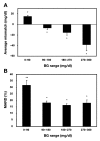Effect of short-term use of a continuous glucose monitoring system with a real-time glucose display and a low glucose alarm on incidence and duration of hypoglycemia in a home setting in type 1 diabetes mellitus
- PMID: 21129341
- PMCID: PMC3005056
- DOI: 10.1177/193229681000400620
Effect of short-term use of a continuous glucose monitoring system with a real-time glucose display and a low glucose alarm on incidence and duration of hypoglycemia in a home setting in type 1 diabetes mellitus
Abstract
Background: The objective of this study was to examine whether setting the low glucose alarm of a Guardian® REAL-Time continuous glucose monitoring system (CGMS) to 80 mg/dl for 3 days and providing instructions to users reduce the risk of hypoglycemia under free-living conditions in individuals with type 1 diabetes mellitus (T1DM).
Methods: Fourteen participants with T1DM aged 26.1±6.0 years (mean±standard deviation) were fitted with a CGMS and assigned for 3 days to either an alarm [low and high blood glucose (BG) alarms set at 80 and 200 mg/dl, respectively] or no alarm condition, with each treatment administered to all participants following a counterbalanced design. All participants were given detailed instructions on how to respond appropriately to low glucose alarms.
Results: The CGMS with alarm reduced the incidence of hypoglycemia (CGMS readings≤65 mg/dl) by 44% as well as the time spent below this hypoglycemic threshold by 64% without increasing average BG levels. However, the CGMS with alarm had no effect on the incidence of symptomatic hypoglycemia.
Conclusions: Short-term use of the CGMS with alarm, together with appropriate instructions for users, reduces the incidence and duration of hypoglycemia, but only to a limited extent, in part because it overestimates BG in the low glucose range.
© 2010 Diabetes Technology Society.
Figures

Comment in
-
Analysis: high-tech diabetes technology and the myth of clinical "plug and play".J Diabetes Sci Technol. 2010 Nov 1;4(6):1465-7. doi: 10.1177/193229681000400621. J Diabetes Sci Technol. 2010. PMID: 21129342 Free PMC article.
Similar articles
-
The effect of short-term use of the Guardian RT continuous glucose monitoring system on fear of hypoglycaemia in patients with type 1 diabetes mellitus.Prim Care Diabetes. 2012 Apr;6(1):35-9. doi: 10.1016/j.pcd.2011.09.004. Epub 2011 Nov 1. Prim Care Diabetes. 2012. PMID: 22047939 Clinical Trial.
-
Analysis: high-tech diabetes technology and the myth of clinical "plug and play".J Diabetes Sci Technol. 2010 Nov 1;4(6):1465-7. doi: 10.1177/193229681000400621. J Diabetes Sci Technol. 2010. PMID: 21129342 Free PMC article.
-
Hypoglycemia alarm enhancement using data fusion.J Diabetes Sci Technol. 2010 Jan 1;4(1):34-40. doi: 10.1177/193229681000400105. J Diabetes Sci Technol. 2010. PMID: 20167165 Free PMC article.
-
Clinical requirements for closed-loop control systems.J Diabetes Sci Technol. 2012 Mar 1;6(2):444-52. doi: 10.1177/193229681200600233. J Diabetes Sci Technol. 2012. PMID: 22538159 Free PMC article. Review.
-
Hypo- and Hyperglycemic Alarms: Devices and Algorithms.J Diabetes Sci Technol. 2015 Apr 30;9(5):1126-37. doi: 10.1177/1932296815583507. J Diabetes Sci Technol. 2015. PMID: 25931581 Free PMC article. Review.
Cited by
-
Reliability of the Dexcom G6 Continuous Glucose Monitor During Hyperbaric Oxygen Exposure.Diabetes Technol Ther. 2020 May;22(5):360-366. doi: 10.1089/dia.2019.0390. Epub 2020 Feb 6. Diabetes Technol Ther. 2020. PMID: 31916854 Free PMC article.
-
Real-World Hypoglycemia Avoidance with a Continuous Glucose Monitoring System's Predictive Low Glucose Alert.Diabetes Technol Ther. 2019 Apr;21(4):155-158. doi: 10.1089/dia.2018.0359. Epub 2019 Mar 22. Diabetes Technol Ther. 2019. PMID: 30896290 Free PMC article.
-
Diabetes Educators' Intended and Reported Use of Common Diabetes-Related Technologies: Discrepancies and Dissonance.J Diabetes Sci Technol. 2016 Nov 1;10(6):1277-1286. doi: 10.1177/1932296816646798. Print 2016 Nov. J Diabetes Sci Technol. 2016. PMID: 27179011 Free PMC article.
-
Physical activity and type 1 diabetes: time for a rewire?J Diabetes Sci Technol. 2015 May;9(3):609-18. doi: 10.1177/1932296814566231. Epub 2015 Jan 6. J Diabetes Sci Technol. 2015. PMID: 25568144 Free PMC article. Review.
-
Increasing the low-glucose alarm of a continuous glucose monitoring system prevents exercise-induced hypoglycemia without triggering any false alarms.Diabetes Care. 2011 Jun;34(6):e109. doi: 10.2337/dc10-2243. Diabetes Care. 2011. PMID: 21617102 Free PMC article. Clinical Trial. No abstract available.
References
-
- Chase HP, Roberts MD, Wightman C, Klingensmith G, Garg SK, VanWyhe M, Desai S, Harper W, Lopatin M, Bartkowiak M, Tamada J, Eastman RC. Use of the GlucoWatch biographer in children with type 1 diabetes. Pediatrics. 2003;111((4 Pt 1)):790–794. - PubMed
-
- Chico A, Vidal-Rios P, Subira M, Novials A. The continuous glucose monitoring system is useful for detecting unrecognized hypoglycemias in patients with type 1 and type 2 diabetes but is not better than frequent capillary glucose measurements for improving metabolic control. Diabetes Care. 2003;26(4):1153–1157. - PubMed
-
- Deiss D, Bolinder J, Riveline JP, Battelino T, Bosi E, Tubiana-Rufi N, Kerr D, Phillip M. Improved glycemic control in poorly controlled patients with type 1 diabetes using real-time continuous glucose monitoring. Diabetes Care. 2006;29(12):2730–2732. - PubMed
-
- Garg SK, Schwartz S, Edelman SV. Improved glucose excursions using an implantable real-time continuous glucose sensor in adults with type 1 diabetes. Diabetes Care. 2004;27(3):734–738. - PubMed
-
- Juvenile Diabetes Research Foundation Continuous Glucose Monitoring Study Group. Tamborlane WV, Beck RW, Bode BW, Buckingham B, Chase HP, Clemons R, Fiallo-Scharer R, Fox LA, Gilliam LK, Hirsch IB, Huang ES, Kollman C, Kowalski AJ, Laffel L, Lawrence JM, Lee J, Mauras N, O’Grady M, Ruedy KJ, Tansey M, Tsalikian E, Weinzimer S, Wilson DM, Wolpert H, Wysocki T, Xing D. Continuous glucose monitoring and intensive treatment of type 1 diabetes. N Engl J Med. 2008;359(14):1464–1476. - PubMed
Publication types
MeSH terms
Substances
LinkOut - more resources
Full Text Sources
Medical

